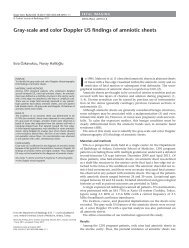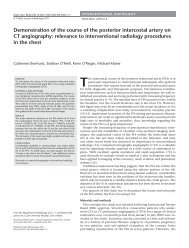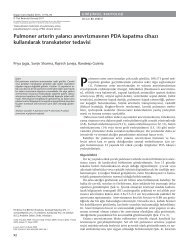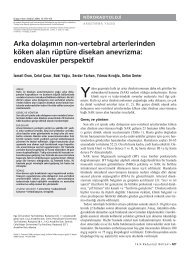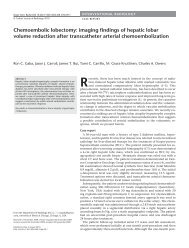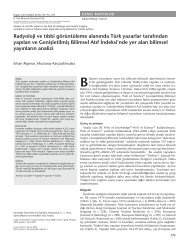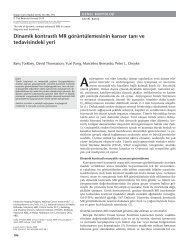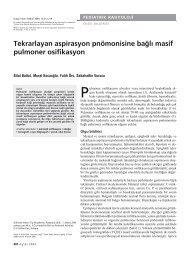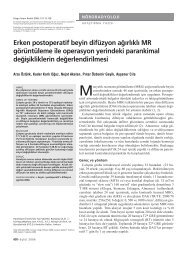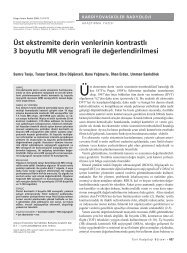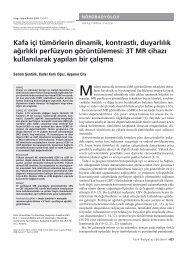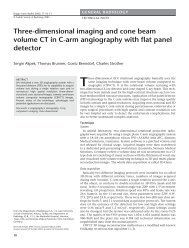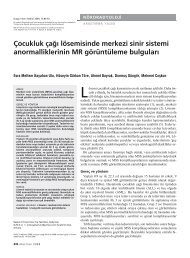Radiological report: expectations of clinicians - Diagnostic and ...
Radiological report: expectations of clinicians - Diagnostic and ...
Radiological report: expectations of clinicians - Diagnostic and ...
You also want an ePaper? Increase the reach of your titles
YUMPU automatically turns print PDFs into web optimized ePapers that Google loves.
Diagn Interv Radiol 2010; 16:179–185<br />
© Turkish Society <strong>of</strong> Radiology 2010<br />
GENERAL RADIOLOGY<br />
ORIGINAL ARTICLE<br />
<strong>Radiological</strong> <strong>report</strong>: <strong>expectations</strong> <strong>of</strong> <strong>clinicians</strong><br />
Nurullah Doğan, Zeynep Nigar Varlıbaş, Özge Petek Erpolat<br />
PURPOSE<br />
Although there have been many publications on composing<br />
an accurate radiological <strong>report</strong>, they usually do not include an<br />
assessment <strong>of</strong> the <strong>clinicians</strong>’ <strong>expectations</strong> from a radiological<br />
<strong>report</strong>. In this study, we aimed to assess the <strong>clinicians</strong>’ <strong>expectations</strong><br />
<strong>and</strong> preferences in terms <strong>of</strong> radiology <strong>report</strong> style <strong>and</strong><br />
content.<br />
MATERIALS AND METHODS<br />
A multiple-choice questionnaire, containing 19 questions, was<br />
formed. Two-hundreds <strong>clinicians</strong>, working either in a university<br />
hospital or a public hospital, were allocated into 4 groups<br />
which included equal number <strong>of</strong> <strong>clinicians</strong> from surgery <strong>and</strong><br />
internal medicine departments. Questionnaire was applied to<br />
participants by face-to-face interview. Results were analyzed<br />
for each group using Pearson chi-square test.<br />
RESULTS<br />
No statistically significant difference was found among four<br />
groups except for the 16 th question which was about the<br />
image format pertaining to the <strong>report</strong> (CD/DVD or negative<br />
film). It has been determined that <strong>clinicians</strong> preferred detailed,<br />
st<strong>and</strong>ardized radiological <strong>report</strong>s with complete sections (i.e.,<br />
clinical information, technique, findings, conclusion, recommendations).<br />
CONCLUSION<br />
This study provided essential data for radiologists to write<br />
more effective <strong>report</strong>s.<br />
Key words: • radiology • communication • st<strong>and</strong>ardization<br />
From the Departments <strong>of</strong> Radiology (N.D. drndogan@gmail.<br />
com), <strong>and</strong> Radiation Oncology (Ö.P.E.), Kütahya Evliya Çelebi<br />
Government Hospital, Kütahya, Turkey; the Department <strong>of</strong><br />
Radiology (Z.N.V.), Uludağ University School <strong>of</strong> Medicine, Bursa,<br />
Turkey.<br />
Received 5 May 2009; revision requested 10 August 2009; revision<br />
received 27 August 2009; accepted 1 September 2009.<br />
Published online 20 July 2010<br />
DOI 10.4261/1305-3825.DIR.2820-09.1<br />
The radiological <strong>report</strong> is the most significant vehicle <strong>of</strong> communication<br />
between a radiologist <strong>and</strong> a clinician, but it is naturally a<br />
one-sided communication. For the most part, radiologists do not<br />
know how their <strong>report</strong>s are evaluated by <strong>clinicians</strong>. Furthermore, radiologists<br />
have individual <strong>and</strong> idiosyncratic ideas about composing <strong>report</strong>s<br />
that vary significantly. Ultimately, there is no consensus on the part <strong>of</strong><br />
<strong>clinicians</strong> or radiologists about radiological <strong>report</strong>ing.<br />
The aim <strong>of</strong> this study was to examine how <strong>clinicians</strong> evaluate radiological<br />
<strong>report</strong>s <strong>and</strong> determine what they expect from a radiologist. The<br />
ultimate goal was to contribute to the st<strong>and</strong>ardization <strong>of</strong> radiological<br />
<strong>report</strong>ing.<br />
Materials <strong>and</strong> methods<br />
Study group selection<br />
This questionnaire-based study included specialists from surgery <strong>and</strong><br />
internal medicine departments. Medical practitioners, residents, fellows,<br />
<strong>and</strong> basic scientists were excluded.<br />
The study was conducted with two hundred doctors; 100 were r<strong>and</strong>omly<br />
selected from public hospitals located in Bursa, Turkey (Çekirge<br />
Public Hospital, İnegöl Public Hospital <strong>and</strong> Ali Osman Sönmez Oncology<br />
Hospital), <strong>and</strong> the other 100 were selected from the Uludağ University<br />
School <strong>of</strong> Medicine Research Hospital. Equal numbers <strong>of</strong> specialists were<br />
selected from the surgery <strong>and</strong> internal medicine departments <strong>of</strong> public<br />
or university hospitals. Thus, four groups were constructed, each including<br />
50 specialists from either university hospitals or public hospitals.<br />
The features <strong>of</strong> the participants, including gender, age, affiliations, <strong>and</strong><br />
academic degrees are shown in Table 1, <strong>and</strong> the distribution <strong>of</strong> those<br />
features by medical department is shown in Table 2.<br />
Questionnaire<br />
A 19-question multiple-choice questionnaire was prepared for the<br />
study. The questions were administered during a face-to-face interview<br />
conducted by radiology residents. The questions obtained were examined<br />
after classifying the answers according to their goals.<br />
The answers to the first 17 questions are shown in Table 3. Answers to<br />
the last two questions were determined by giving sample <strong>report</strong>s to the<br />
participants <strong>and</strong> asking them to choose the most appropriate one (Samples<br />
1 <strong>and</strong> 2 are shown in Tables 4 <strong>and</strong> 5, respectively). The results were<br />
assessed with the sample <strong>report</strong>s that the participants found to be sufficient<br />
<strong>and</strong>, comparing those results to the answers <strong>of</strong> other questions.<br />
Statistical analyses<br />
Analyses were performed with SPSS s<strong>of</strong>tware, version 11 (SPSS Inc.,<br />
Chicago, USA). Results from the four groups were analyzed separately<br />
179
Table 1. Participant demographics<br />
University hospital<br />
Public hospital<br />
Female 30 23<br />
Male 70 77<br />
Average age, range 44 (30–66) 45(29–62)<br />
Pr<strong>of</strong>essor 47 -<br />
Associate pr<strong>of</strong>essor 19 -<br />
Assistant pr<strong>of</strong>essor 14 -<br />
Specialist 20 100<br />
Table 2. Distribution <strong>of</strong> the participants by medical department<br />
<strong>and</strong> compared using the Pearson chisquared<br />
test. P values less than or equal<br />
to 0.05 were considered statistically<br />
significant.<br />
Research ethics compliance<br />
This study was approved by the<br />
Uludağ University Medical Research<br />
Committee (decision number, 2008-<br />
12/30, June 10, 2008) <strong>and</strong> was conducted<br />
from July 1, 2008, to August 31,<br />
2008. Informed consent was obtained<br />
from all participants.<br />
University hospital<br />
180 • September 2010 • <strong>Diagnostic</strong> <strong>and</strong> Interventional Radiology<br />
Public hospital<br />
Cardiac <strong>and</strong> vascular surgery 3 3<br />
Cardiology 1 1<br />
Chest surgery 2 4<br />
Dermatology - 2<br />
Emergency medicine 4 4<br />
Gynecology 6 8<br />
Infectious diseases 2 2<br />
Internal medicine 12 14<br />
Neurology 4 4<br />
Neurosurgery 3 3<br />
Ophthalmology 7 5<br />
Orthopedics 1 2<br />
Otorhinolaryngology 5 4<br />
Pediatric surgery 5 2<br />
Pediatrics 14 12<br />
Physical therapy 5 5<br />
Plastic surgery 2 1<br />
Psychiatry 2 1<br />
Pulmonary diseases 5 3<br />
Radiation oncology 4 6<br />
Sports medicine 1 -<br />
Surgery 9 10<br />
Urology 3 4<br />
Results<br />
We first asked the <strong>clinicians</strong> questions<br />
about the sufficiency <strong>of</strong> the <strong>report</strong>s,<br />
<strong>and</strong> 60%, 29%, 4.5%, 3.5%, <strong>and</strong><br />
3% <strong>of</strong> the <strong>clinicians</strong> stated that 75%,<br />
50%,
Table 3. The first seventeen questions <strong>of</strong> the questionnaire <strong>and</strong> their answer choices<br />
Question 1: If you generalize, what percentage <strong>of</strong> radiology <strong>report</strong>s are sufficient?<br />
Answers: a) 100%<br />
b) 75%<br />
c) 50%<br />
d) 25%<br />
e)
Table 4. Sample <strong>report</strong> given in the 18 th question<br />
18 th question: If you assess the <strong>report</strong> samples below, drawn up for a chest radiograph, which level <strong>of</strong> content do you prefer?<br />
Clinical condition: Status post operation due to gastric cancer, follow-up.<br />
Pathology: There are nodules in the lungs, <strong>and</strong> both <strong>of</strong> the costodiaphragmatic sinuses are blunt.<br />
Answers:<br />
a. Short <strong>report</strong>:<br />
There are nodules located diffusely in bilateral lung parenchyma. Given the patient is <strong>report</strong>ed to have gastric cancer, this appearance is considered most likely<br />
to represent metastases. Both <strong>of</strong> the costodiaphragmatic sinuses are blunt. Other than this finding, the structures included in this radiograph are normal.<br />
b. Report with limited details:<br />
There is a total <strong>of</strong> 5 nodules. The largest one is 1.5 x 1 cm in size <strong>and</strong> is in the parenchyma <strong>of</strong> the left lung. Two nodules smaller than 1 cm are found in the<br />
parenchyma <strong>of</strong> the right lung. Given the patient is <strong>report</strong>ed to have gastric cancer, these are considered most likely to represent metastases. Both <strong>of</strong> the<br />
costodiaphragmatic sinuses are blunt (?pleural fluid/adhesion). S<strong>of</strong>t tissues <strong>and</strong> bones in this radiograph are normal.<br />
c. Detailed <strong>report</strong>:<br />
Clinical information: Status post operation due to gastric cancer, follow-up.<br />
Findings:<br />
There is a nodule 1.5 x 1 cm in size in the lower zone <strong>of</strong> the left lung, <strong>and</strong> there is another nodule 1 x 1 cm in size at the upper zone <strong>of</strong> the left lung. There are<br />
also 3 nodules smaller than 1 cm near the nodule in the upper zone <strong>of</strong> the left lung, <strong>and</strong> there are 2 close nodular formations smaller than 1 cm in the lower<br />
zone <strong>of</strong> the right lung. Given the patient is <strong>report</strong>ed to have gastric cancer, these are considered most likely to represent metastases. Further evaluation <strong>of</strong> the<br />
patient with thoracic computed tomography is recommended.<br />
Both <strong>of</strong> the costodiaphragmatic sinuses are blunt (?pleural fluid/adhesion). Both <strong>of</strong> the hiluses are normal. Mediastinal width <strong>and</strong> cardiothoracic ratio are normal.<br />
No major bony abnormality was detected in this roentgenogram. No mass lesion was found.<br />
Conclusion: There are many nodular formations in the parenchyma <strong>of</strong> both lungs. The largest one is located at the lower zone <strong>of</strong> the left lung (metastasis?). Both<br />
<strong>of</strong> the costodiaphragmatic sinuses are blunt (?pleural fluid/adhesion). Further evaluation <strong>of</strong> the patient with thoracic computed tomography is recommended.<br />
Table 5. Sample <strong>report</strong> given in the 19 th question<br />
19 th question: If you assessed the <strong>report</strong> samples below, which were drawn up for lumbar magnetic resonance imaging, which <strong>report</strong> would you prefer with<br />
regards to content?<br />
Answers:<br />
a. Summary <strong>report</strong>:<br />
T1-weighted sagittal, T2-weighted sagittal <strong>and</strong> axial, <strong>and</strong> T1-weighted sagittal <strong>and</strong> axial cross-sectional images after contrast administration were obtained from<br />
a 46-year-old female patient with a complaint <strong>of</strong> lumbago. Alignment <strong>and</strong> heights <strong>of</strong> the lumbar vertebrae are normal. Disk spaces <strong>and</strong> intensities are normal.<br />
There is a thickening <strong>of</strong> the L4-L5 <strong>and</strong> L5-S1 disks, <strong>and</strong> minimal protrusion at the central part <strong>of</strong> the L4-L5 disk. No compression <strong>of</strong> the nerve roots was found.<br />
After contrast agent administration, no pathologic enhancement was observed.<br />
b. Detailed <strong>report</strong>:<br />
Clinical information: A 46-year-old female patient has a complaint <strong>of</strong> lumbago extending to her right leg that increases with activity for 2 months.<br />
Technique: T1-weighted <strong>and</strong> T2-weighted axial, <strong>and</strong> T1-weighted sagittal images have been obtained from T11 to S1. T1-weighted sagittal <strong>and</strong> axial images<br />
were again taken after IV administration <strong>of</strong> 0.5 mmol Gd-DTPA.<br />
Findings:<br />
Alignment <strong>and</strong> heights <strong>of</strong> the lumbar vertebrae <strong>and</strong> intervertebral disk spaces are normal. No pathological signal intensity change was observed.<br />
Signal intensity <strong>of</strong> the medulla spinalis, <strong>and</strong> thecal sac extension are normal.<br />
The conus medullaris ends in the normal location. No defective appearance was seen in the posterior spinal elements.<br />
On the axial cross-sections at the level <strong>of</strong> T11–L1, disk <strong>and</strong> neural foramina were normal. No compression was observed on bilateral nerve roots.<br />
On the axial cross-sections at the level <strong>of</strong> L2–L3, disk <strong>and</strong> neural foramina were normal. No compression was observed on bilateral nerve roots.<br />
On the axial cross-sections at the level <strong>of</strong> L3–L4, disk <strong>and</strong> neural foramina were normal. No compression was observed on bilateral nerve roots.<br />
On the axial cross-sections at the level <strong>of</strong> L4–L5, there was minimal protrusion at the central basilar part <strong>of</strong> the thickened disk. Neural foramina were normal, <strong>and</strong><br />
no compression was observed on bilateral nerve roots.<br />
On the axial cross-sections at the level <strong>of</strong> L5–S1, thickening <strong>of</strong> the disc was observed. Neural foramina were normal, <strong>and</strong> no compression was observed on<br />
bilateral nerve roots.<br />
On the post-contrast images, no pathological contrast enhancement was observed.<br />
Conclusion: Thickening <strong>of</strong> the L4–L5 <strong>and</strong> L5–S1 disks with minimal protrusion on the central part <strong>of</strong> L4–L5 disk.<br />
started with the most important lesion.<br />
Interestingly, 53.5% thought that<br />
there should be a printed <strong>report</strong> format,<br />
<strong>and</strong> the lesion should be defined<br />
there (in italics or bold) when describing<br />
the lesion structure <strong>and</strong> pathology.<br />
Although 37.5% <strong>of</strong> <strong>clinicians</strong> evaluated<br />
the description <strong>of</strong> basic anatomic<br />
structures as sufficient, 36% percent <strong>of</strong><br />
<strong>clinicians</strong> asked for a description <strong>of</strong> all<br />
<strong>of</strong> the examined anatomical structures.<br />
Other <strong>clinicians</strong> (26.5%) evaluated the<br />
description <strong>of</strong> normal anatomic structures<br />
as unnecessary, <strong>and</strong> 35% <strong>of</strong> the<br />
participants considered <strong>report</strong>ing <strong>of</strong><br />
the normal results as unnecessary. Interestingly,<br />
32% <strong>of</strong> the participants<br />
asked for the <strong>report</strong>ing <strong>of</strong> the anatomic<br />
structure, even if it was normal because<br />
they wanted the information to<br />
assist in the assessment <strong>of</strong> the clinical<br />
condition (e.g., sizes <strong>of</strong> the liver for a<br />
patient who is under follow up due to<br />
the diagnosis <strong>of</strong> hepatitis). In addition,<br />
19.5% <strong>of</strong> the <strong>clinicians</strong> asked for the <strong>report</strong>ing<br />
<strong>of</strong> measures <strong>of</strong> basic anatomic<br />
structures (e.g., size <strong>of</strong> the spleen), <strong>and</strong><br />
13.5% <strong>of</strong> the subjects requested measurement<br />
results (e.g., size, diameter) <strong>of</strong><br />
all <strong>of</strong> the anatomical structures, even if<br />
they were in the normal range.<br />
In response to the 11 th question<br />
which was about the certainty with<br />
which the radiologist <strong>report</strong>s an abnormal<br />
finding (Table 3), 56% <strong>of</strong> <strong>clinicians</strong><br />
commented that they were sometimes<br />
182 • September 2010 • <strong>Diagnostic</strong> <strong>and</strong> Interventional Radiology<br />
Doğan et al.
uncertain <strong>of</strong> the radiological diagnosis<br />
based on the clinical data they provided.<br />
The majority <strong>of</strong> <strong>clinicians</strong> (70.5%)<br />
thought that a recommendations section<br />
at the end <strong>of</strong> the <strong>report</strong> would be<br />
helpful. However, a recommendations<br />
section was not believed to be helpful<br />
by 29.5% <strong>of</strong> the <strong>clinicians</strong>: 9.5% expressed<br />
that “patients reading those<br />
recommendations put the <strong>clinicians</strong> in<br />
a tight spot”, 8.5% stated that “the clinician<br />
will decide which examination<br />
he will request”, <strong>and</strong> 11.5% suggested<br />
both <strong>of</strong> the causes.<br />
Most <strong>of</strong> the <strong>clinicians</strong> who participated<br />
in our questionnaire (73%) opposed<br />
a <strong>report</strong> written using Turkish<br />
terms. The <strong>clinicians</strong> requested the use<br />
<strong>of</strong> universal medical terminology for<br />
the following reasons: 15% suggested<br />
that “patients read the <strong>report</strong>”, 28.5%<br />
suggested that “everybody knows this<br />
universal medical terminology”, <strong>and</strong><br />
29.5% put forward both <strong>of</strong> the reasons.<br />
The 14 th question addressed the<br />
marking <strong>of</strong> lesions, <strong>and</strong> 73% <strong>of</strong> the<br />
<strong>clinicians</strong> requested marking <strong>of</strong> the lesion.<br />
In answer to the question, 14% requested<br />
this as a cross-sectional image<br />
number <strong>of</strong> the lesion, 16.5% requested<br />
this as marking on the film, <strong>and</strong> 42.5%<br />
requested both.<br />
When we asked the <strong>clinicians</strong> how<br />
they preferred to receive the <strong>report</strong>,<br />
we found that sending it with the patient<br />
or their relatives was sufficient<br />
with 85% <strong>of</strong> the <strong>clinicians</strong>. Only 27%<br />
requested the <strong>report</strong> in a closed envelope,<br />
2% <strong>of</strong> the <strong>clinicians</strong> preferred receiving<br />
the <strong>report</strong> by courier, <strong>and</strong> 13%<br />
<strong>of</strong> the <strong>clinicians</strong> preferred receiving the<br />
<strong>report</strong> electronically (e.g., e-mail, hospital<br />
operating system).<br />
With the questions so far, no statistically<br />
significant difference was found<br />
between <strong>clinicians</strong> at public or university<br />
hospitals. Interestingly, there was a<br />
significant difference between these two<br />
groups <strong>of</strong> <strong>clinicians</strong> (P = 0.005) when<br />
they were asked about the examination<br />
imagery format attached to the <strong>report</strong><br />
(16 th question). The answers to the<br />
16 th question are shown in Table 6. Although<br />
37% <strong>of</strong> <strong>clinicians</strong> at public hospitals<br />
preferred the examination to be<br />
printed on negative film, we found that<br />
<strong>clinicians</strong> working at a university hospital<br />
preferred a CD or DVD. Interestingly,<br />
only 18% <strong>of</strong> the <strong>clinicians</strong> working in<br />
public hospitals preferred a CD or DVD.<br />
When the answers to other options <strong>of</strong><br />
both the groups were evaluated together,<br />
we found that 13.5% <strong>of</strong> the <strong>clinicians</strong><br />
marked the option “presentation <strong>of</strong> the<br />
image is not important if the patient<br />
has a sufficient <strong>report</strong>”, <strong>and</strong> 10% <strong>of</strong> the<br />
<strong>clinicians</strong> marked the option “only the<br />
pathological lesions should be printed<br />
on a film”. Furthermore, we did not<br />
find any differences between groups according<br />
to the classification <strong>of</strong> <strong>clinicians</strong><br />
into their surgery or internal medicine<br />
department (P > 0.05).<br />
Finally, we attempted to underst<strong>and</strong><br />
how much assistance the <strong>clinicians</strong><br />
wanted to get from consultations with<br />
radiologists, <strong>and</strong> 75.5% percent <strong>of</strong> the<br />
<strong>clinicians</strong> indicated at least some level<br />
<strong>of</strong> assistance: 43.5% <strong>of</strong> the subjects<br />
answered “occasionally”, <strong>and</strong> 32% <strong>of</strong><br />
the subjects expressed that they would<br />
“regularly” consult radiologists. Conversely,<br />
16.5% <strong>of</strong> the <strong>clinicians</strong> did not<br />
feel that they needed help from the<br />
radiologists <strong>and</strong> stated, “If I need to,<br />
I will call <strong>and</strong> ask my radiologist colleagues,<br />
so there is no need for an extra<br />
consultant”. Another 4.5% <strong>of</strong> <strong>clinicians</strong><br />
stated, “It is not required, I rarely<br />
need to discuss cases <strong>and</strong> I can always<br />
contact my other specialist colleagues<br />
when I do (not a radiologist)”.<br />
The answers to all <strong>of</strong> the questions<br />
according to the choices given are<br />
shown in Table 7.<br />
Discussion<br />
The only communication vehicle<br />
between a radiologist <strong>and</strong> a clinician<br />
is a <strong>report</strong>, which is composed by the<br />
radiologist. A clinician only knows<br />
the radiologist by his/her <strong>report</strong>s, <strong>and</strong><br />
the radiologist usually does not know<br />
the clinician who is receiving his/her<br />
<strong>report</strong>. Most radiologists do not know<br />
how their not <strong>report</strong>s are evaluated or<br />
what is expected by <strong>clinicians</strong> in the<br />
radiological <strong>report</strong>s.<br />
Although there are many <strong>report</strong>s<br />
about radiological examinations <strong>and</strong><br />
the quality <strong>of</strong> <strong>report</strong>s (1–6), few studies<br />
have examined the <strong>clinicians</strong>’ <strong>expectations</strong><br />
<strong>of</strong> radiologists. Clinger et al. (7)<br />
were the first researchers to examine<br />
<strong>clinicians</strong>’ <strong>expectations</strong> for radiological<br />
<strong>report</strong>s. In a study by McLoughlin<br />
et al. (4), they found that radiologists<br />
did not pay sufficient attention to the<br />
requests <strong>of</strong> the clinician who referred<br />
the patient.<br />
In our study, we initially asked the<br />
<strong>clinicians</strong> some questions about the<br />
sufficiency <strong>of</strong> radiological <strong>report</strong>s.<br />
The <strong>report</strong>s <strong>of</strong> university origin were<br />
deemed to be more sufficient (96.5%).<br />
The latter percentage was higher than<br />
the <strong>report</strong>s from public hospitals or<br />
private imaging centers. These findings<br />
may be the result <strong>of</strong> the high quality <strong>of</strong><br />
examinations in the university hospital,<br />
which was <strong>report</strong>ed in the study <strong>of</strong><br />
Ozsunar et al. (2). In the Ozsunar et al.<br />
study, the examinations were categorized<br />
into three groups: university hospital,<br />
state hospital <strong>and</strong> private health<br />
center. These groups were compared<br />
for overall quality <strong>of</strong> examinations.<br />
There was no difference between the<br />
state hospitals <strong>and</strong> the private health<br />
centers. However, there were significant<br />
differences between the university<br />
<strong>and</strong> state hospitals (P = 0.03) <strong>and</strong> the<br />
university <strong>and</strong> private health centers (P<br />
= 0.04). They stated that quality control<br />
<strong>and</strong> st<strong>and</strong>ardization was becoming<br />
more important in radiological services.<br />
According to the Ozsunar et al.<br />
study, we believe that the high quality<br />
<strong>of</strong> the examinations was related to the<br />
sufficient <strong>report</strong>s.<br />
The greatest request <strong>of</strong> radiologists<br />
to <strong>clinicians</strong> is that they include some<br />
clinical information; however, when<br />
this happens, the information is usually<br />
insufficient or it is not legible. The<br />
conditions that contain written clinical<br />
information on the request form,<br />
which is required for the diagnosis <strong>of</strong><br />
the patient, are not common. According<br />
to our study, 53.5% <strong>of</strong> <strong>clinicians</strong><br />
write sufficient clinical information,<br />
<strong>and</strong> 41.5% note only short amounts <strong>of</strong><br />
clinical information. The description<br />
<strong>of</strong> clinical information is different for<br />
radiologists <strong>and</strong> <strong>clinicians</strong>.<br />
One <strong>of</strong> the issues amongst radiologists<br />
pertains to what should be contained<br />
in the results section <strong>of</strong> the <strong>report</strong>.<br />
Some radiologists compose short<br />
<strong>report</strong>s by focusing on the pathological<br />
state while others draw up very detailed<br />
<strong>report</strong>s about every structure<br />
observed (sometimes about structures<br />
not observed as well). When we asked<br />
the <strong>clinicians</strong> how they react to a long<br />
<strong>report</strong>, 39% stated that they read the<br />
whole <strong>report</strong>. We decided to evaluate<br />
the answer to this question in combination<br />
with the answers to the last<br />
two (18 th <strong>and</strong> 19 th ) questions <strong>of</strong> the<br />
questionnaire. In the 18 th question,<br />
very short, not detailed <strong>and</strong> detailed<br />
types <strong>of</strong> <strong>report</strong>s were presented, <strong>and</strong><br />
the participants were asked which one<br />
they preferred. Most <strong>of</strong> the participants<br />
(72%) preferred the detailed <strong>report</strong>. In<br />
Volume 16 • Issue 3<br />
<strong>Radiological</strong> <strong>report</strong>: <strong>expectations</strong> <strong>of</strong> <strong>clinicians</strong> • 183
Table 6. The answers <strong>of</strong> the participants to the 16 th question, according to the type <strong>of</strong> institution<br />
Question 16: How should the images be provided in addition the <strong>report</strong> (CD, DVD, negative film)?<br />
Answers: a. In CD or DVD format.<br />
b. Printing the full examination on negative films (not important to be economical).<br />
c. a+b (the most expensive preference).<br />
d. Only the pathologic lesions should be printed on the negative film.<br />
e. Presentation <strong>of</strong> the image is not important if the patient has a sufficient <strong>report</strong>.<br />
Answers University hospital Public hospital<br />
a 52 18<br />
b 20 37<br />
c 15 11<br />
d 3 17<br />
e 10 17<br />
Table 7. The percentages <strong>of</strong> answers to all questions according to the choices given<br />
Questions<br />
1 2 3 4 5 6 7 8 9 10 11 12 13 14 15 16 17 18 19<br />
a 3 3.5 53.5 4 46.5 65 92.5 36 13.5 9.5 28.5 30.5 15 27 58 35 3.5 5.5 35.5<br />
Choices<br />
b 60 33.5 41.5 46 53.5 35 - 37.5 19.5 8.5 15.5 56 28.5 14 27 28.5 32 22.5 64.5<br />
c 29 26 5 11 7.5 26.5 32 11.5 56 13.5 29.5 16.5 2 13 43.5 72<br />
d 3.5 37 - 39 35 70.5 27 42.5 13 10 16.5<br />
e 4.5 13.5 4.5<br />
the 19 th question, two <strong>report</strong> examples<br />
for the same patient were presented;<br />
one was in short form, <strong>and</strong> the other<br />
was a st<strong>and</strong>ardized, detailed <strong>report</strong>. Almost<br />
65% <strong>of</strong> the <strong>clinicians</strong> preferred<br />
the st<strong>and</strong>ardized, detailed <strong>report</strong>. In<br />
both <strong>of</strong> these questions, pathology<br />
was indicated in the same manner.<br />
The only difference was the addition<br />
<strong>of</strong> the normal structures to the <strong>report</strong><br />
or a change in the presentation <strong>of</strong> the<br />
<strong>report</strong>, which included sections for<br />
clinical information, methods, findings<br />
<strong>and</strong> conclusion. When the <strong>report</strong><br />
was evaluated with the results <strong>of</strong> the<br />
three questions, we found that <strong>clinicians</strong><br />
preferred st<strong>and</strong>ardized, detailed<br />
<strong>report</strong>s regardless <strong>of</strong> whether they read<br />
the whole <strong>report</strong>. In a study by Naik<br />
et al. (8) that examined 25 radiologists<br />
<strong>and</strong> 95 <strong>clinicians</strong>, six different <strong>report</strong><br />
samples with three clinical scenarios<br />
were formed similarly to our 18 th <strong>and</strong><br />
19 th questions, <strong>and</strong> participants were<br />
asked which <strong>report</strong> they preferred.<br />
This study also found that most <strong>of</strong> the<br />
participants preferred st<strong>and</strong>ardized, detailed<br />
<strong>report</strong>s.<br />
A series <strong>of</strong> questions was designed<br />
to underst<strong>and</strong> what qualified as a sufficient<br />
<strong>report</strong>. Most <strong>of</strong> the <strong>clinicians</strong><br />
requested a detailed description about<br />
all <strong>of</strong> the features <strong>of</strong> each lesion regardless<br />
<strong>of</strong> the number <strong>of</strong> lesions. In addition,<br />
most <strong>of</strong> the <strong>clinicians</strong> requested<br />
lesion descriptions that indicated the<br />
features that could be commented on<br />
by <strong>clinicians</strong> (e.g., calcification, necrosis,<br />
hemorrhage) rather than the use <strong>of</strong><br />
radiologic terminology. However, this<br />
request was for a diagnosis that is more<br />
appropriately made by a pathologist,<br />
though it was still expected from the<br />
radiologist.<br />
Furthermore, there was no consensus<br />
amongst the <strong>clinicians</strong> about the<br />
format <strong>of</strong> the <strong>report</strong>. Similarly, there<br />
was no consensus about <strong>report</strong>ing the<br />
results <strong>of</strong> normal measures. In a study<br />
by Naik et al. (8), the authors were not<br />
sure about the examination <strong>of</strong> the organ<br />
if it was not noted in the <strong>report</strong>.<br />
However, in the same study, most <strong>of</strong><br />
the participants preferred st<strong>and</strong>ardized,<br />
printed <strong>report</strong>s, which did not agree<br />
with the present findings. In another<br />
study, Gagliardi (3) emphasized the<br />
significance <strong>of</strong> st<strong>and</strong>ardized <strong>report</strong>s.<br />
Similarly, in an evaluation performed<br />
on 104 <strong>clinicians</strong>, Lafortune et al. (9)<br />
concluded that “radiological <strong>report</strong>s<br />
should be explicit, should give direct<br />
answers to clinical questions requested<br />
<strong>and</strong> should contain findings <strong>and</strong> conclusion<br />
sections”.<br />
When the <strong>clinicians</strong> were asked how<br />
they interpreted an uncertain finding<br />
in the radiologist’s <strong>report</strong>, 28% stated<br />
that they considered all uncertain sentences<br />
as positive for pathology. This<br />
finding is very interesting <strong>and</strong> must be<br />
taken seriously. Interpreting all uncertain<br />
sentences as positive for pathology<br />
will affect the treatment <strong>of</strong> the<br />
patient, <strong>and</strong> mistakes that are made<br />
in the comments <strong>of</strong> suspected lesions<br />
may have serious consequences. Only<br />
15.5% <strong>of</strong> the subjects stated that they<br />
might request additional examinations<br />
due to uncertain expressions.<br />
Interestingly, in situations where the<br />
conclusion is not definitive but there<br />
is suspicion <strong>of</strong> a positive pathology, a<br />
recommendation <strong>of</strong> additional examinations<br />
would be an integral part <strong>of</strong><br />
the <strong>report</strong>. Similar to the findings in<br />
the Lafortune et al. study (9), which<br />
found that the radiological <strong>report</strong><br />
should contain conclusion <strong>and</strong> recommendation<br />
sections, the present<br />
study found that a recommendations<br />
section was requested by the majority<br />
<strong>of</strong> the <strong>clinicians</strong>.<br />
184 • September 2010 • <strong>Diagnostic</strong> <strong>and</strong> Interventional Radiology<br />
Doğan et al.
Reporting in Turkish terms has been<br />
an issue in radiological <strong>report</strong>s in Turkey<br />
for years. Recently, a number <strong>of</strong><br />
reviews (10–13) have recommended<br />
the use <strong>of</strong> Turkish terms in radiological<br />
<strong>report</strong>s, which is in opposition to our<br />
study. Indeed, the present study found<br />
that most <strong>clinicians</strong> do not want the<br />
patients to read the <strong>report</strong>s, <strong>and</strong> they<br />
stated that the use <strong>of</strong> universal medical<br />
terms between medical doctors supported<br />
better communication.<br />
We also determined that opinions<br />
on issues such as marking a lesion on<br />
the film <strong>and</strong> transporting the <strong>report</strong> to<br />
the clinician in a way that does not<br />
allow the patient to see the content<br />
<strong>of</strong> the <strong>report</strong> (e.g., by courier) were<br />
widely accepted by radiologists but<br />
not agreed upon by <strong>clinicians</strong>. We<br />
determined that <strong>clinicians</strong> expected<br />
sections <strong>of</strong> the <strong>report</strong>s to be complete<br />
<strong>and</strong> expected a section describing recommendations.<br />
Additionally, most <strong>of</strong><br />
the <strong>clinicians</strong> stated that they wanted<br />
to communicate with radiologists via<br />
consultation before <strong>and</strong> after the radiologic<br />
examination.<br />
Limitations <strong>of</strong> our study included<br />
the general limitations <strong>of</strong> studies based<br />
on questionnaires. A primary limitation<br />
is that this was a sampling study<br />
conducted only around Bursa, Turkey.<br />
Therefore, we cannot claim that it represents<br />
all <strong>of</strong> the <strong>clinicians</strong> around the<br />
whole country or world. Additionally,<br />
the experimental groups were heterogeneous<br />
groups containing many specialties.<br />
Different results would likely<br />
be obtained if the questionnaire were<br />
used in a larger, more homogenous<br />
group (e.g., neurologists, surgeons).<br />
The present study also contained some<br />
subjectivity, which is a common feature<br />
<strong>of</strong> studies based on questionnaires.<br />
The accuracy <strong>of</strong> the answers is only<br />
possible if the subjects answer honestly.<br />
This accuracy, however, cannot be<br />
tested objectively with a questionnaire<br />
method.<br />
We believe that the present study<br />
provided essential data for radiologists<br />
to write more effective <strong>report</strong>s. If this<br />
questionnaire was modified <strong>and</strong> applied<br />
to a larger, more homogenous<br />
group, it would be possible to test our<br />
results <strong>and</strong> obtain new data.<br />
Acknowledgement<br />
We would like to express our gratitude to<br />
Ercan Tuncel, MD, who gave us the opportunity<br />
to complete our study. The preparation <strong>of</strong><br />
the manuscript would not have been possible<br />
without his support.<br />
References<br />
1. Tuncel E. Radyogramların değerlendirilmesi<br />
ve rapor yazma. Tani Girisim Radyol 1996;<br />
2:5–10.<br />
2. Özsunar Y, Çetin M, Taşkın F, et al. The<br />
level <strong>of</strong> quality <strong>of</strong> radiology services in<br />
Turkey: a sampling analysis. Diagn Interv<br />
Radiol 2006; 12:166–170.<br />
3. Gagliardi RA. The evolution <strong>of</strong> the X-<br />
ray <strong>report</strong>. AJR Am J Roentgenol 1995;<br />
164:501–502.<br />
4. McLoughlin RF, So CB, Gray RR, Br<strong>and</strong>t<br />
R. Radiology <strong>report</strong>s: how much descriptive<br />
detail is enough? AJR Am J Roentgenol<br />
1995; 165:803–806.<br />
5. Schreiben MH, Leonard JM, Rieniets CY.<br />
Disclosure <strong>of</strong> imaging findings to patients<br />
directly by radiologists: survey <strong>of</strong> patients’<br />
preferences. AJR Am J Roentgenol 1995;<br />
165:467–469.<br />
6. Stavema K, Fossa T, Botnmarka O,<br />
Andersend OK, Erikssenb J. Inter-observer<br />
agreement in audit <strong>of</strong> quality <strong>of</strong> radiology<br />
requests <strong>and</strong> <strong>report</strong>s. Clin Radiol 2004;<br />
59:1018–1024.<br />
7. Clinger NJ, Hunter TB, Hillman BJ.<br />
Radiology <strong>report</strong>ing: attitudes <strong>of</strong> referring<br />
physicians. Radiology 1988; 169:825–826.<br />
8. Naik SS, Hanbidge A, Wilson SR. Radiology<br />
<strong>report</strong>s: examining radiologist <strong>and</strong> clinician<br />
preferences regarding style <strong>and</strong> content.<br />
AJR Am J Roentgenol 2001; 176:591–598.<br />
9. Lafortune M, Breton G, Baudouin J. The<br />
radiological <strong>report</strong>: what is useful for the<br />
referring physician? J Can Assoc Radiol<br />
1988; 39:140–143.<br />
10. Aydıngöz Ü. Radyoloji dili: temel<br />
sorunlarımız. Tani Girisim Radyol 2003;<br />
9:5–9.<br />
11. Akan H. Tıpça üzerine Türkçe düşünceler.<br />
Tani Girisim Radyol 2003; 9:131–134.<br />
12. Berkmen YM. Bilim dilinin Türkçeleşmesi.<br />
Tani Girisim Radyol 2003; 9:275–278.<br />
13. Işık S. Bilim dili Türkçe. Tani Girisim<br />
Radyol 2004;10:93–95.<br />
Volume 16 • Issue 3<br />
<strong>Radiological</strong> <strong>report</strong>: <strong>expectations</strong> <strong>of</strong> <strong>clinicians</strong> • 185



